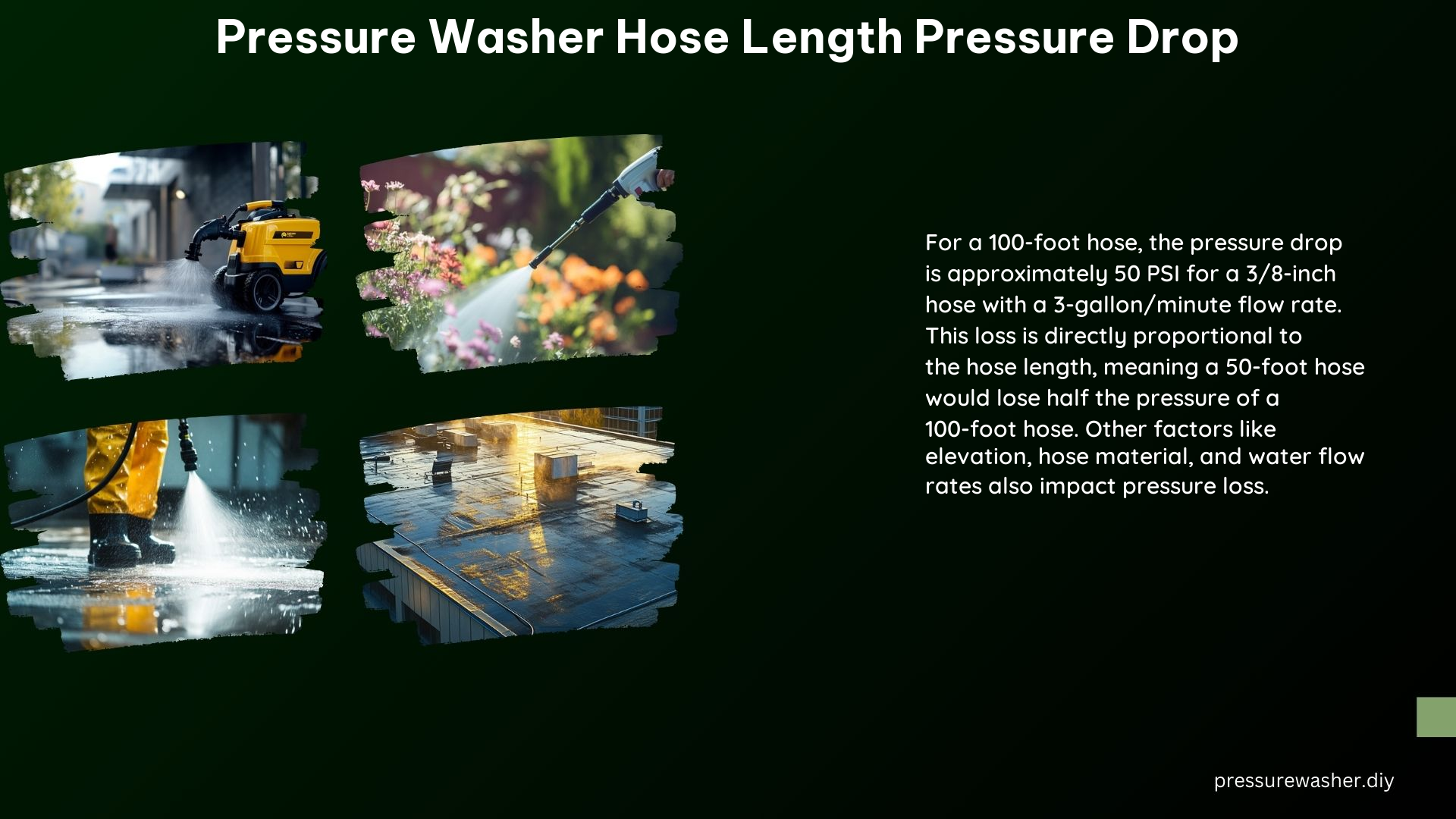Pressure washers are essential tools for various cleaning tasks, but their performance can be significantly affected by the length of the hose. The hose length can lead to pressure drop, which can reduce the overall effectiveness of the pressure washer. Here, we will delve into the details of how hose length impacts pressure washer performance and provide technical specifications to help you make informed decisions.
Pressure Loss Due to Elevation
One crucial factor to consider is the elevation of the spray gun above the pressure washer. As the gun is positioned higher, more pressure is lost due to the effort required to lift the water. The chart below illustrates the pressure loss due to elevation:
| Elevation of Gun Above Pressure Washer (in FT) | Pressure Loss due to Elevation (in PSI) |
|---|---|
| 0 | 0 |
| 10 | 4 |
| 20 | 9 |
| 30 | 13 |
| 40 | 17 |
| 50 | 22 |
| 100 | 43 |
| 200 | 87 |
According to the chart, for every 10 feet of elevation, the pressure washer loses approximately 4 PSI of pressure. This pressure loss is due to the increased work required to lift the water to a higher level, which reduces the overall pressure available at the spray gun.
Hose Friction Pressure Loss

Hose friction also contributes to pressure loss. The pressure drop across a given hose length is directly proportional to the length. For instance, a 50-foot hose will lose exactly half the pressure of a 100-foot hose. The chart below presents the approximate pressure drop in PSI per 100 feet of hose for different water flow rates and hose inner diameters:
| Water Flow GPM | Hose Inside Diameters, Inches |
|---|---|
| 1 | 54 (1/4″), 20 (5/16″), 7 (3/8″), 2 (1/2″), – (5/8″), – (3/4″), – (1″) |
| 2 | 180 (1/4″), 60 (5/16″), 25 (3/8″), 6 (1/2″), 2 (5/8″), – (3/4″), – (1″) |
| 3 | 380 (1/4″), 120 (5/16″), 50 (3/8″), 13 (1/2″), 4 (5/8″), 2 (3/4″), – (1″) |
| 4 | – (1/4″), 220 (5/16″), 90 (3/8″), 24 (1/2″), 7 (5/8″), 3 (3/4″), – (1″) |
| 5 | – (1/4″), 320 (5/16″), 130 (3/8″), 34 (1/2″), 10 (5/8″), 4 (3/4″), – (1″) |
| 6 | – (1/4″), – (5/16″), 220 (3/8″), 52 (1/2″), 16 (5/8″), 7 (3/4″), 1 (1″) |
| 8 | – (1/4″), – (5/16″), 300 (3/8″), 80 (1/2″), 25 (5/8″), 10 (3/4″), 2 (1″) |
| 10 | – (1/4″), – (5/16″), – (3/8″), 120 (1/2″), 38 (5/8″), 14 (3/4″), 3 (1″) |
| 15 | – (1/4″), – (5/16″), – (3/8″), 250 (1/2″), 80 (5/8″), 30 (3/4″), 7 (1″) |
| 20 | – (1/4″), – (5/16″), – (3/8″), – (1/2″), 121 (5/8″), 50 (3/4″), 12 (1″) |
| 25 | – (1/4″), – (5/16″), – (3/8″), – (1/2″), 200 (5/8″), 76 (3/4″), 19 (1″) |
| 40 | – (1/4″), – (5/16″), – (3/8″), – (1/2″), 410 (5/8″), 162 (3/4″), 42 (1″) |
| 60 | – (1/4″), – (5/16″), – (3/8″), – (1/2″), – (5/8″), 370 (3/4″), 93 (1″) |
This table provides the approximate pressure drop in PSI per 100 feet of hose for different water flow rates and hose inner diameters. For example, a 1 GPM flow through a 1/2-inch hose would result in a 2 PSI pressure drop per 100 feet of hose, while a 10 GPM flow through a 3/4-inch hose would result in a 14 PSI pressure drop per 100 feet of hose.
Factors Affecting Pressure Loss
Several factors contribute to pressure loss in pressure washer hoses:
- Hose Length: Longer hoses result in greater pressure loss due to friction. For every 100 feet of hose, the pressure drop can range from 2 PSI to 410 PSI, depending on the water flow rate and hose diameter.
- Hose Inner Diameter: Smaller diameters lead to higher pressure loss. A 1/4-inch hose can have up to 54 PSI of pressure drop per 100 feet, while a 1-inch hose may only have 1-3 PSI of pressure drop per 100 feet.
- Water Flow Rate: Higher flow rates result in greater pressure loss. A 1 GPM flow can have a pressure drop of 2-54 PSI per 100 feet, while a 60 GPM flow can have a pressure drop of 93 PSI per 100 feet.
- Elevation: Higher elevations of the spray gun above the pressure washer lead to greater pressure loss. For every 10 feet of elevation, the pressure washer loses approximately 4 PSI of pressure.
- Hose Material and Smoothness: Rougher hose interiors and lower-quality materials can increase pressure loss by creating more friction.
- Fittings and Connections: Poorly fitted connections can also contribute to pressure loss by creating turbulence and resistance in the water flow.
Technical Specifications
- Hose Material: Cold-water pressure washers typically use hoses made of rubber or thermoplastic, while hot-water machines require hoses made of more heat-resistant materials like high-pressure braided hoses.
- PSI Rating: Ensure the hose is rated for the pressure washer’s PSI output to avoid damage and ensure optimal performance. Using a hose with a lower PSI rating than the pressure washer can lead to hose failure and safety hazards.
- Hose Reels: Using hose reels can help manage longer hoses and reduce wear, as the hose is less likely to kink or become tangled when stored on a reel.
Conclusion
In conclusion, the length of a pressure washer hose significantly impacts its performance. Understanding the factors contributing to pressure loss, such as elevation, hose friction, and water flow rate, is crucial for selecting the right hose for your application. By considering these factors and choosing the appropriate hose length and material, you can optimize your pressure washer’s performance and achieve better cleaning results.
References
- Ultimate Washer. (n.d.). Hose Pressure Loss. Retrieved from https://www.ultimatewasher.com/hose-pressure-loss.htm
- Power Washers Online. (n.d.). Hose Friction Loss in Pressure Washer Hose. Retrieved from https://www.pressurewashersonline.com/pages/hose-friction-loss-in-pressure-washer-hose
- Brunner Tool and Repair. (2021, July 29). How Hose Length Affects Pressure. Retrieved from https://brunnertool.com/how-hose-length-affects-pressure/
- Pressure Washer Supply. (2024, April 29). Do Pressure Washers Work Better With Longer Hoses? Retrieved from https://www.pressurewashersupply.com/blogs/pressure-washer-attachment-guides/picking-the-right-pressure-washer-hose-length
- Hotsy Carlson. (2024, February 2). Pressure Washer: Does the length of your hose really make a difference? Retrieved from https://www.hotsycarlson.com/under-pressure-how-hose-length-affects-clean
